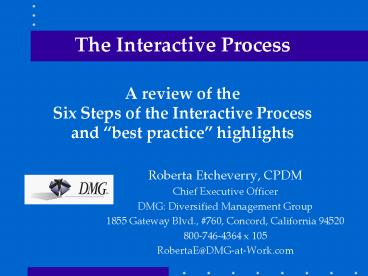The Interactive Process A review of the Six Steps of the Interactive Process and best practice highl - PowerPoint PPT Presentation
1 / 18
Title:
The Interactive Process A review of the Six Steps of the Interactive Process and best practice highl
Description:
and 'best practice' highlights. Roberta Etcheverry, CPDM. Chief ... O*Net (Occupational Information Network) as a resource: http://online.onetcenter.org ... – PowerPoint PPT presentation
Number of Views:131
Avg rating:3.0/5.0
Title: The Interactive Process A review of the Six Steps of the Interactive Process and best practice highl
1
The Interactive Process A review of the Six
Steps of the Interactive Process and best
practice highlights
- Roberta Etcheverry, CPDM
- Chief Executive Officer
- DMG Diversified Management Group
- 1855 Gateway Blvd., 760, Concord, California
94520 - 800-746-4364 x 105
- RobertaE_at_DMG-at-Work.com
2
The Law
- ADA vs. FEHA
- Both require the employer to consider
accommodations for employees and applicants with
disabilities - FEHA (not the only differences)
- Broader definition of criteria for disability
- REQUIREMENT to conduct an Interactive Process
- Will focus on FEHA as more stringent
3
What is Required?
- FEHA generally requires two things
- (related to employer obligations and
employees/applicants with disabilities) - Employers must provide reasonable accommodation
for those applicants and employees who, because
of their disability, are unable to perform the
essential functions of the job. - Employers must engage in a timely, good faith
interactive process with applicants or employees
in need of reasonable accommodation.
4
What is the Interactive Process?
- State law incorporates guidelines developed by
EEOC in defining an interactive process between
the employer and employee - The guidelines include
- Consulting with the individual to ascertain the
precise job-related limitations and how they
could be overcome with a reasonable
accommodation. - Identifying potential accommodations and
assessing their effectiveness.
5
What is good faith timely?
- Federal courts have given an interpretation of
good faith - ER/EE must communicate directly with each other
to determine essential information needed - Neither party can delay or interfere with the
process - The employer should be able to point to
cooperative behavior that promotes the
identification of an appropriate accommodation - Act quickly and avoid unnecessary delays
- at least START the process ASAP
6
What triggers the process?
- An oral or written request for an accommodation
by an employee (does not need to refer to ADA,
FEHA or use the phrase reasonable
accommodation) - My wheelchair does not fit under my desk
- I have problems getting to work at my start time
- because of medical treatments I am undergoing
- I need time off to get treatment for a back
problem - (continued)
7
What triggers the process?
- A request is made or the employer otherwise
learns of a request for accommodation from a
third party (spouse, friend, doctor) - Employees wife calls telling the employer that
employee had a medical emergency due to MS,
needed to be hospitalized, and therefore needs
time off - Employee given restrictions related to W.Comp
claim - Employer observes employee with an obvious
disability having difficulty performing the
essential functions of the job.
8
The Interactive Process
- Remember it is harder to do the wrong thing
when you are trying to do the right thing
9
Six Steps of the Interactive Process
- A highlight of best practices
- STEP 1 Analyze the job and essential
- functions
10
Essential Functions
- Who decides? How??
- Help from the EEOC
11
Essential Functions Identification
- Taking the criteria and applying them to the
specific circumstances. - Beware of canned job descriptions OK as a
starting point, but need to make sure they fit
your organization. - ONet (Occupational Information Network) as a
resource - http//online.onetcenter.org/
12
Six Steps of the Interactive Process
- STEP 2 Identify job-related limitations
- If the disability is not obvious, can request
that the employee complete a Request for
Reasonable Accommodation that includes providing
medical documentation of the disability and need
for accommodation can also request clarification
on restrictions related to the disability - Do not delay the start of the process while
waiting for information - Do not rely entirely on the doctor for
accommodation ideas EMPLOYER is the decision
maker, not the doctor when it comes to
accommodations
13
Six Steps of the Interactive Process
- STEP 3 Identify possible accommodations
- The employees involvement is key
- Do not be afraid to brainstorm
- What to do when the EE will not interact
- JAN as a resource
- (www. JAN.wvu.edu)
14
Six Steps of the Interactive Process
- STEP 4 Assess the feasibility of accommodations
- Getting supervisors to buy in
- Focus on business necessity/operations
- Do not need to remove Essential Functions
- Undue hardship to business operations
- Direct threat employee would create imminent
and substantial danger to self or others by
performing the job
15
Six Steps of the Interactive Process
- STEP 5 Implement the accommodation that
- is the most appropriate
- EE preference vs. ER constraints
- Document the offer
- Have an action plan
16
Six Steps of the Interactive Process
- STEP 6 Follow up regularly
- Must go back to the drawing board if not working
- Was the action plan followed to completion?
- Does the work continue to be within the
functional limitations? - Is the employee successfully performing the
essential functions?
17
Key Points to Remember
- The interactive process is interactive
- The interactive process is a process (not an
event) - Documentation, documentation
- It is harder to do the wrong thing when you are
trying to do the right thing
18
Questions ?...
Roberta Etcheverry RobertaE_at_DMG-at-Work.com 800-7
46-4364 x 105






























